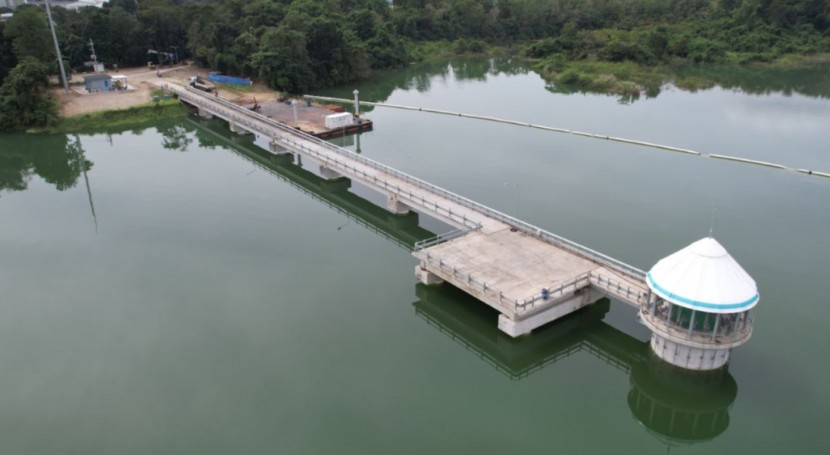East Zone concessionaire Manila Water recently inaugurated one of its flagship projects that seeks to boost water security and service reliability for its more than 7.4 million customers in eastern Metro Manila and Rizal Province. This major water project augurs well with the government’s “Build Better More” program, which prioritizes the build of infrastructure as a key engine for growth and economic development.
The P5.6-B Novaliches-Balara Aqueduct 4 or NBAQ4 project consists of laying a 7.3-kilometer, 3.1-diameter aqueduct underneath Commonwealth Avenue via a tunnel boring machine, a first in an urban setting the country. Other components of the project include the construction of an intake facility at the La Mesa Reservoir, an outlet structure at the Balara Treatment Plant 2, and the downstream network system. An aqueduct is a pipe, a tunnel or any form of structure constructed to convey water from a source to a distant distribution point.
Currently, there are 3 aqueducts connecting the La Mesa Reservoir to the Balara Treatment Plants (BTP) 1 and 2. Aqueducts 1, 2 and 3 were laid in 1929, 1956, and 1968 respectively, and have been carrying up to 1,600 million liters of raw water per day (MLD) to Manila Water’s water treatment plants which is the entire allocation for the East Zone. This, in turn, does not leave any opportunity to assess the continued viability of the existing concrete aqueducts, with the oldest now nearing its century-old mark. The service life for concrete structures such as these aqueducts is normally pegged at 50 years.
The risk of ageing infrastructure and the rising demand for water supply in relation to continued increase in population continues to accentuate the critical need for another conveyance system to avert any impending disaster should any one of these ageing aqueducts be compromised; hence, Manila Water embarked on the project of building a 4th aqueduct.
 A first in Metro Manila, the NBAQ4 Project used a tunnel-boring machine (TBM)
A first in Metro Manila, the NBAQ4 Project used a tunnel-boring machine (TBM)
The urgency of completing the NBAQ4 necessitated addressing major construction challenges such as the presence of informal settlers along and within the aqueduct alignment and the planned facilities as well as the monstrous traffic that may be caused if construction will adopt the conventional open excavation method along the busy Commonwealth. Avenue. As an innovative solution, the Manila Water project team opted to use a machine to create a tunnel underneath the major thoroughfare. The construction consortium Novaliches-Balara Joint Venture (NovaBala JV) formed by contractors CMC Di Ravenna, First Balfour Phils, and Chun Wo Construction brought in the tunnel boring machine (TBM) to be used for the project in September 2018, the same technology being used to build the government’s Metro Manila Subway System. Construction of its entry shaft at Balara begun shortly thereafter, and by January 28, 2020, the TBM, christened “Dalisay”, a Filipino word meaning pure and refined, was officially launched.
Despite the COVID-19 pandemic hitting the Philippines just a couple of months after the start of the NBAQ4’s construction, “Dalisay” finally completed its work on August 14, 2021, when the tunnel head broke through at its exit shaft at the La Mesa Reservoir. Part of Dalisay’s unique journey was digging as deep as 71 meters beneath Commonwealth Avenue and making an 84-degree turn moving towards La Mesa. It was the first time in the Philippines a TBM was used in an urban setting.
With the completion of the NBAQ4 last year, the sequential temporary service suspension of the 3 existing aqueducts for inspection, assessment, and subsequent rehabilitation may now be conducted. The NBAQ4 will also provide emergency redundancy in the event of a failure in any of the existing aqueducts.
Manila Water considers the NBAQ4 as one of its biggest milestones in its 25 years in service, as the Company relies highly on the 3 old aqueducts in providing 24/7 water supply to its customers in the East Zone of Metro Manila and Rizal.
“Part of our service obligation is safeguarding the quality of life of our 7.4 million customers, providing 24/7 water supply and making sure it will be sustained through projects like the NBAQ4. Moving forward, we will continue to invest on water security, service continuity, service accessibility and environmental sustainability, allotting P181-B for our Service Improvement Plan for the next 5 years,” says Jocot De Dios, Manila Water President and CEO.




